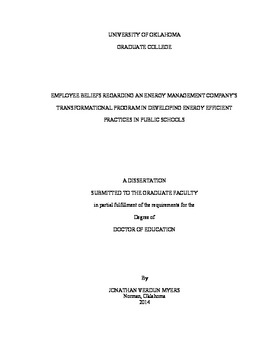| dc.description.abstract | Public schools throughout the United States of America are experiencing financial hardship (Oliff, Mai, & Leachman, 2012), and due to the turbulence and fluctuation of state budgets, sound funding and competent budgeting practices are essential assets needed in operating a school system (Maguad, 2007). During times of financial hardship, school boards and district administrators will need to assess where monies can be conserved. Utility expenditures are an expense for public schools that many stakeholders do not take into consideration. A typical school district will spend $400,000 annually on utility bills, while those in large metropolitan areas may spend $20 million or more (USDOE, 2002). Although energy costs to run a public school district are high, energy consumption and costs can be managed intelligently (USDOE, 2008). To assist public school districts in implementing an energy conservation program, an energy management company may be needed; and if so, a viable company will need to be assessed as to their qualifications to lead an energy initiative. In Oklahoma, several public schools have or are in the process of using energy companies. The purpose of this exploratory study was to determine the effectiveness of one such company to determine if the company’s transformational energy program was successful in changing employee behavior and beliefs, therefore contributing to the conservation of energy. Utilizing a descriptive survey and means testing procedures, the study assessed whether there were statistically significant differences in employee energy conservation behaviors and beliefs between elementary school and secondary school employees, the type of heating, ventilation, air conditioning (HVAC) control system within an employee’s work space, and the years of employment of an employee within the district. This study also investigated if specific factors need to be in place for employees to support and sustain their district’s energy conservation program. Using organizational learning as a theoretical framework, this nonexperimental quantitative study found that learning did occur within the organizations and the company did have an impact on employees’ behaviors and beliefs. When comparing employees’ prior and after survey responses, the results for employees’ behavior and beliefs showed statistically significant differences. However, when testing for the independent variables, the majority of the results indicated that there were no statistically significant differences. Some of the statements that did show statistically significant differences indicated that employees with manual thermostats were more concerned with the energy being consumed by their HVAC system during unoccupied times. Additionally, some statements indicated there were some statistically significant differences between first year employees and employees with four or more years of employment. Finally, this study concluded that the three most popular reasons why employees supported and will continue to support their district’s energy conservation initiative is if the program continues to save the school district money, is communicated on a regular basis, and monitored for compliance. | en_US |
